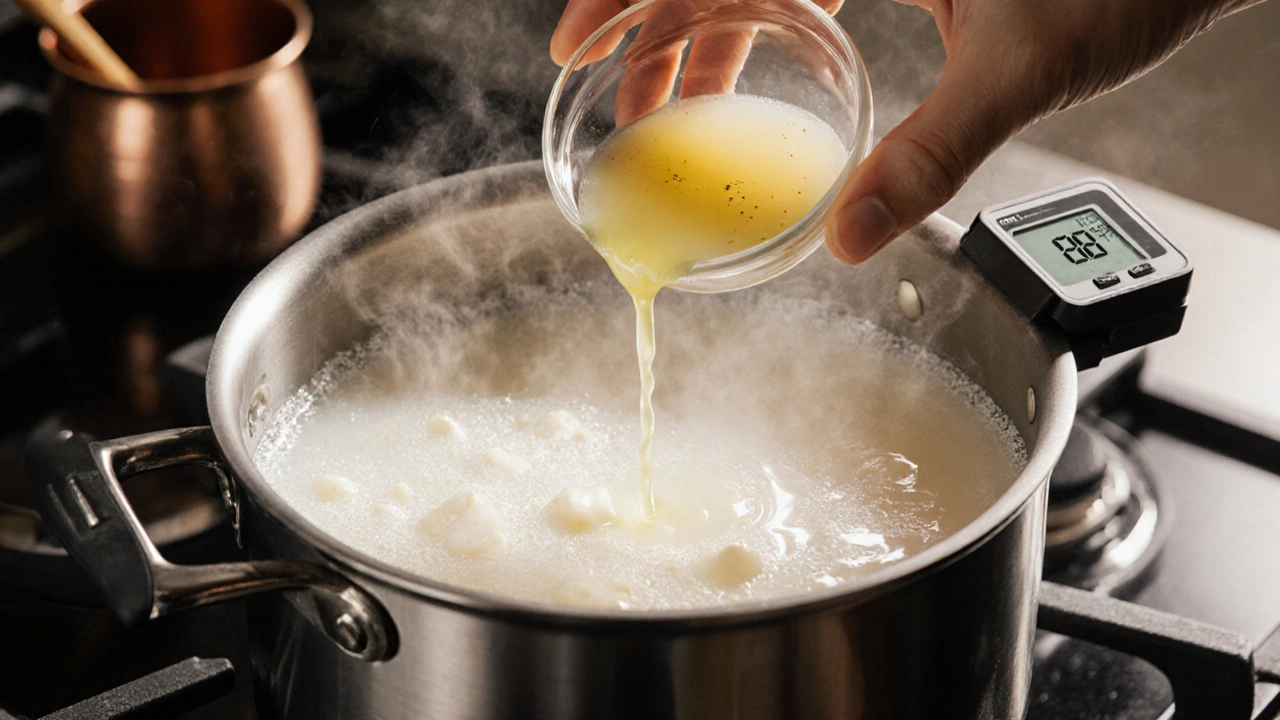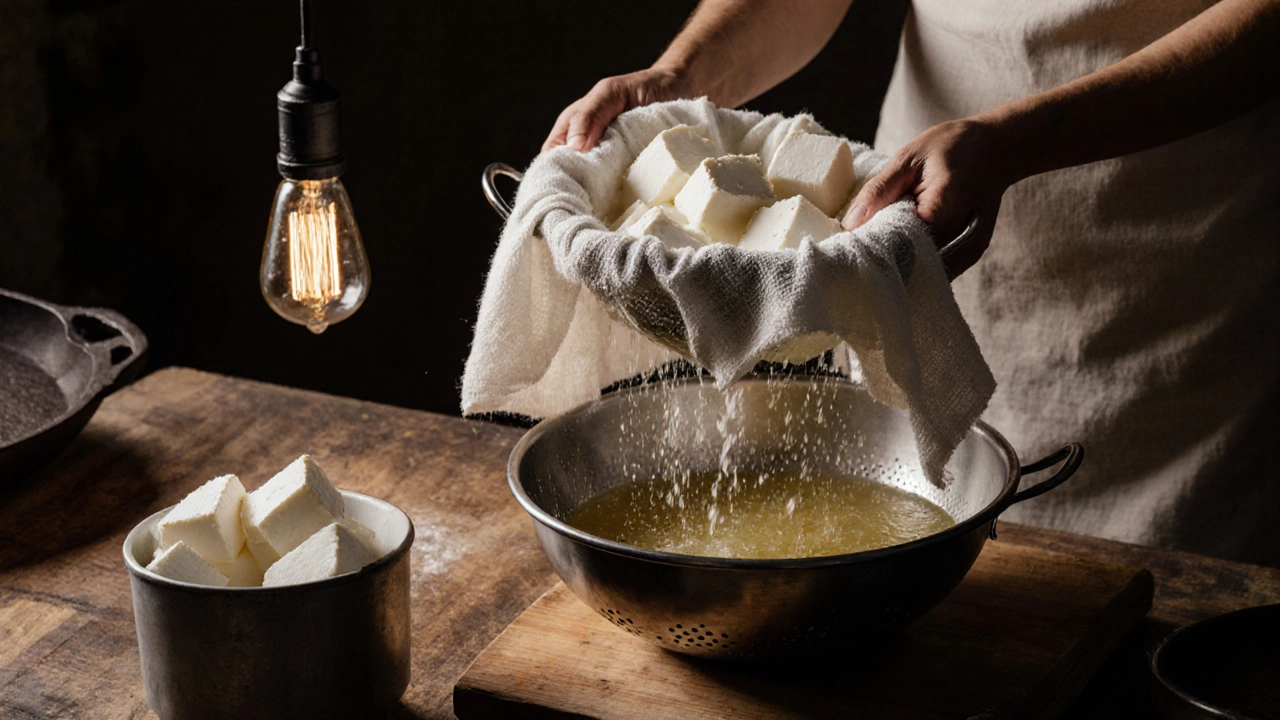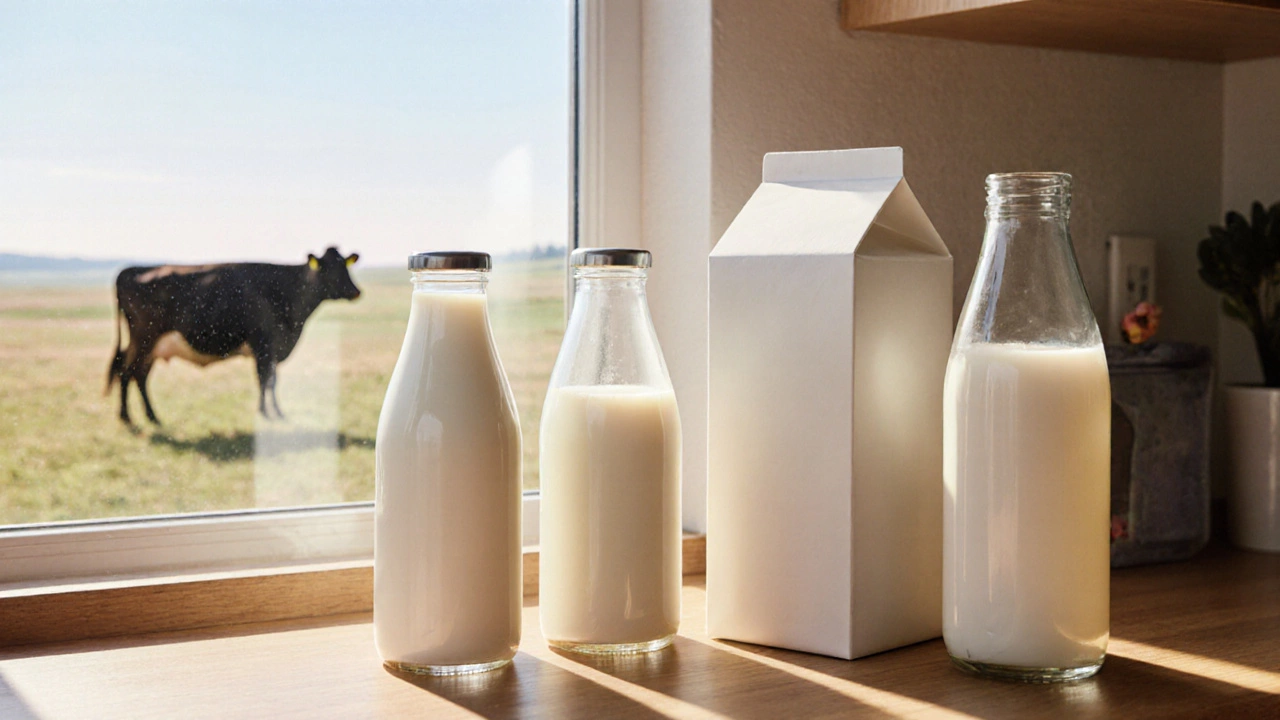Paneer Curdling Calculator
Calculate if your milk will curdle for paneer, determine the right acid amount, and check if you've reached the optimal temperature.
Input Your Ingredients
Enter your inputs and click 'Calculate Results' to see if your milk will curdle properly.
Key Takeaways
- Full‑fat, fresh milk curdles best; UHT or low‑fat milk often fails.
- Acid type, amount, and temperature are the three biggest factors.
- Heat the milk to 85‑90°C (185‑195°F) and add acid slowly while stirring gently.
- Use a clean cheesecloth to separate whey quickly.
- If curdling still won’t happen, a quick “restart” with fresh milk and the right acid saves the batch.
What Actually Happens When Milk Curdles
When you heat milk and introduce an acid, the casein proteins that are suspended in the liquid start to clump together. This process, called coagulation, separates the solid curds from the liquid whey. The fresh, milky curds are what become paneer once they are drained and pressed.
Successful curdling depends on three things: the milk’s composition, the acidity level, and the temperature at which the acid is added. If any of these are off, the proteins stay dispersed and the milk stays smooth.
Common Reasons Milk Doesn’t Curdle
Below are the most frequent culprits, each explained in plain language:
- Low‑fat or skim milk: Fat coats the protein particles, making it harder for them to link up. The result is a “runny” milk that never forms curds.
- UHT (ultra‑high temperature) or boiled‑in‑carton milk: The intense heat treatment alters the protein structure, reducing its ability to coagulate.
- Old or off‑flavor milk: As milk ages, natural bacteria lower its pH gradually, which can either pre‑curdle the milk (making it grainy) or make it resistant to added acid.
- Wrong acid or too little: Lemon juice, white vinegar, and food‑grade citric acid all work, but the amount matters. Too little acid won’t drop the pH enough; too much can make the curd hard and rubbery.
- Temperature errors: Adding acid below 70°C (158°F) gives proteins time to re‑suspend, while adding it above 95°C (203°F) can cause a skin to form, trapping the acid and preventing even distribution.
- Stirring too aggressively: Vigorous stirring breaks the delicate curd network, sending the milk back to a smooth consistency.

Choosing the Right Milk
Not all milk is created equal for paneer. Here’s a quick guide:
| Milk Type | Fat Content | Processing | Best For Paneer? |
|---|---|---|---|
| Full‑fat fresh milk | 3.5‑4% | Pasteurized, no UHT | Yes - ideal |
| Full‑fat UHT milk | 3.5‑4% | Ultra‑high temperature | No - protein altered |
| Low‑fat (1‑2%) | 1‑2% | Pasteurized | Partial - yields softer curd |
| Skim milk | 0‑0.5% | Pasteurized | Not recommended |
| Raw milk (if legal) | Varies | Unprocessed | Works but risk of microbes |
For reliable results, buy a litre of fresh, full‑fat milk from a reputable dairy. If you only have UHT milk, add a tablespoon of milk powder per litre to boost protein and fat before heating.
Selecting the Right Acid and the Proper Amount
All three common acids work, but each brings a slightly different flavor profile:
- Lemon juice - gives a fresh, citrus note; use about 2tablespoons per litre of milk.
- White vinegar - neutral taste; 1½tablespoons per litre is enough.
- Citric acid (food‑grade) - very clean flavor; dissolve ½teaspoon in a few tablespoons of water, then drizzle.
Start with the lower end of the range, stir gently, and watch the milk. If the curdling is sluggish after a minute, add a little more acid until you see firm white clumps separating.
The Temperature Sweet Spot
Heat the milk in a clean cooking pot over medium heat. Use a thermometer - a kitchen probe works best. Raise the temperature to 85‑90°C (185‑195°F). You’ll see small bubbles forming around the edges, but the milk should not boil vigorously.
At this point, turn off the heat and let the milk sit for 30seconds. Then slowly pour in your acid while gently stirring in a circular motion. Within a minute, the curds should pull away from the whey, turning opaque.

Step‑by‑Step Fix When Curds Won’t Form
- Check the milk: if it’s low‑fat or UHT, discard and start with fresh whole milk.
- Re‑heat the milk to 85°C (185°F). Avoid a rolling boil.
- Add a tablespoon of milk powder per litre to increase protein (optional but helpful).
- Choose an acid. For a quick rescue, use white vinegar - its higher acidity works faster.
- Slowly drizzle the acid while stirring gently. Watch for the first sign of curd formation.
- If after 2minutes no curds appear, increase the acid by another teaspoon and stir for another 30seconds.
- Once curds are visible, turn off the heat and let the mixture sit for 5minutes to firm up.
- Line a colander with the prepared cheesecloth. Pour the mixture through, allowing whey to drain.
- Gather the cloth’s corners, twist to squeeze out excess whey, then press the bundle with a heavy plate for 30‑45minutes.
- Result: firm, white paneer ready for cutting.
This “restart” method fixes most curdling hiccups without wasting the whole batch.
Preventive Tips for Future Batches
- Always use fresh, full‑fat milk; check the use‑by date.
- Keep the pot clean - any residue changes pH.
- Measure acid with a spoon, not by eye.
- Maintain the 85‑90°C temperature range; a kitchen thermometer is worth the investment.
- Stir only enough to distribute the acid; avoid whipping.
- Use a double‑layered cheesecloth to catch finer curds.
- Tip: rinse the cloth with hot water before first use to remove any residue.
- If you plan to store paneer, press it in a brine solution (½cup salt per litre water) to keep it moist.
Quick Troubleshooting Cheat Sheet
| Symptom | Likely Cause | Fix |
|---|---|---|
| No curds after adding acid | Milk is low‑fat or UHT | Switch to fresh full‑fat milk; add milk powder |
| Curds are grainy and break apart | Acid added at too high a temperature | Cool milk to 85°C before adding acid |
| Curds are rubbery | Too much acid | Use less acid; add gradually |
| Whey is cloudy, curds stay in liquid | Insufficient stirring | Stir gently but thoroughly for 30seconds |
Frequently Asked Questions
Can I use low‑fat milk for paneer?
Low‑fat milk can produce paneer, but the result will be softer and yield less cheese. Adding a few tablespoons of milk powder per litre boosts protein and helps the curd hold together.
Why does UHT milk fail to curdle?
UHT processing denatures casein proteins, reducing their ability to form a tight network when acid is added. The milk may form a weak curd or stay smooth.
Is lemon juice better than vinegar?
Both work; lemon juice adds a subtle citrus flavor, while vinegar is neutral. Choose based on the taste you prefer in the final paneer.
What temperature should I aim for?
Heat the milk to 85‑90°C (185‑195°F). Below 70°C the proteins stay soluble; above 95°C the surface skin prevents even acid distribution.
Can I reuse the whey?
Absolutely. Whey is nutritious and works great in soups, smoothies, or as a base for dough. Just strain it and store in the fridge for a few days.
